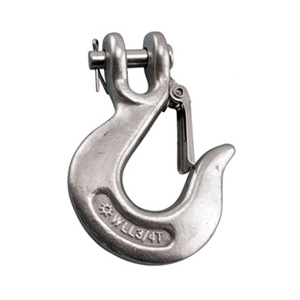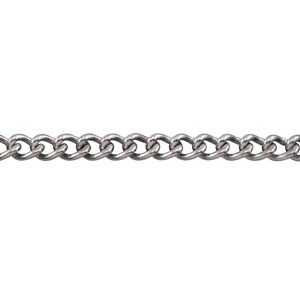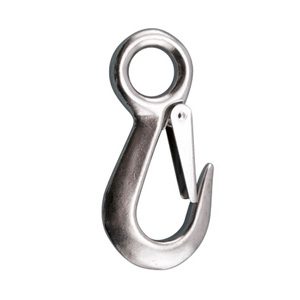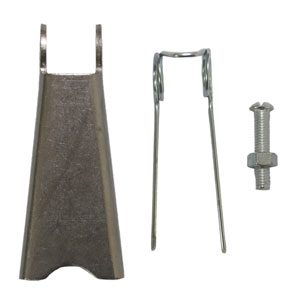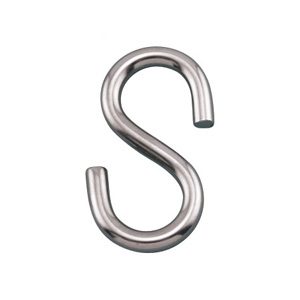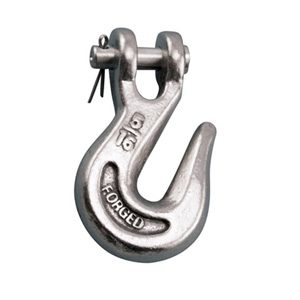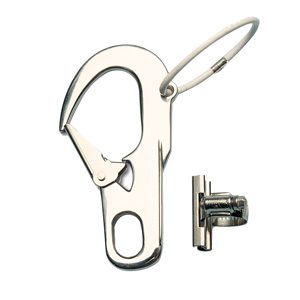- Type 316 stainless steel & drop forged
- WLLs are based on gradual pull, not shock loads
- Includes removable latch & clevis pin
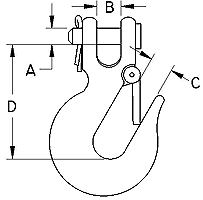
| Part # | Size (in) | A (in) |
B (in) |
C (in) |
D (in) |
WLL (lb) |
Wt (lb) |
| HKCS14SS | 1/4 | 0.37 | 0.41 | 0.58 | 2.57 | 1,000 | 0.57 |
| HKCS516SS | 5/16 | 0.36 | 0.40 | 0.83 | 2.73 | 1,500 | 0.82 |
| HKCS38SS | 3/8 | 0.47 | 0.43 | 0.95 | 3.04 | 2,000 | 1.14 |
| HKCS12SS | 1/2 | 0.54 | 0.50 | 1.05 | 3.53 | 3,000 | 2.13 |
Stainless Steel Information Center
General Information
The many unique values provided by stainless steel make it a powerful candidate in materials selection. Engineer, specifiers and designers often underestimate or overlook these values because of what is viewed as the higher initial cost of stainless steel. However, over the total life of a project, stainless steel is often the best value option.
What is Stainless Steel?
Stainless steel is essentially a low carbon steel which contains chromium at 10% or more by weight. It is this addition of chromium that gives the steel its unique stainless, corrosion resisting properties.
The chromium content of the steel allows the formation of a rough, adherent, invisible, corrosion-resisting chromium oxide film on the steel surface. If damaged mechanically or chemically, this film is self-healing, providing that oxygen, even in very small amounts, is present The corrosion resistance and other useful properties of the steel are enhanced by increased chromium content the the addition of other elements such as molybdenum, nickel and nitrogen.
There are more than 60 grades of stainless steel. However, the entire group can be divided into five classes. Each goup os stainles steel is identified by the alloying elements which affect their microstructure and for which each is named.
Benefits of Stainless Steel
Corrosion Resistance
Lower alloyed grades resist corrosion in atmospheric and pure water environments, while high-alloyed grades can resist corrosion in most acids, alkaline solutions and chlorine bearing environments, properties which are utilized in process plants.
Fire and Heat Resistance
Special high chromium and nichel-alloyed grades of stainless steel resist scaling and retain strength at high temperatures.
Hygiene
The easy cleaning ability of stainless steel makes it the first choice for strict hygiene conditions, such as hospitals, kitchens, abattoirs and other food processing plants.
Strength-to-Weight Advantage
The work-hardening property of austenitic grades of stainless steel, that results in a significant strengthening of the material from cold-working alone, and the high strength duplex grades, allow reduced material thickness over conventional grades, therefor cost savings.
Ease of Fabrication
Modern steel-making techniques mean that stainless steel can be cut, welded, formed, machine and fabricated as readily as traditional steels.
Impact Resistance
The austenitic microstructure of the 300 series provides high toughness, from elevated temperatures to far below freezing, making these steels particularly suited to cryogenic applications.
Long Term Value
When the total life cycle costs are considered, stainless steel is often the least expensive material option. Stainless steel products complete their service life. There is less concern about disposal since this material is 100% recyclable. In fact, over 50% of new stainless steel comes from old remelted stainless steel scrap, thereby completing the full life cycle.
Electropolishing
Electropolishing is primarily used to obtain a bright, clean appealing surface of the stainless steel. However it also passivates the surface while removing burrs, sharp edges, microscopic nicks and scratches from the surface. It can smooth threads and remove heat discoloration form spot or TIG welds. Suncor electropolishes products to the ASTM STandard A967.
Passivating
Technically, passivation is not cleaning but is a process of dipping fitting into an acid solution to rapidly form a chromium oxide on the surface of the material, creating a passive film that protects stainless steel from further oxidation (see PASSIVE FILM). In common commercial terms (meaning non-military and aerospace), passivating means cleaning and the terms “passivating” and “cleaning” are used interchangeably. AN/MS/NAS fittings sold by Suncor have been cleaned, descaled, and passivated to the applicable engineering specifications.
Glossary of Terminology
AN – Stands for Air Force-Navy
ANSI – Stands for American National Standards Institute
ASME – Stands for American Society of Mechanical Engineers
ASTM – Stands for American Society of Testing and Materials
ANNEAL – To heat a metal in order to lower its hardness. The term anneal refers to the heat treatment given to 300 series of stainless steel and most 400 series stainless by the steel mill after the raw material has been completed, but before fittings are manufactured. Anneal also refers to the heat treatment given 400 series stainless fittings after their manufacture (also called hardening and tempering) to lower hardness and increase toughness. For example, fittings of 410 stainless steel may score over 200,000 psi after manufacture and be too brittle. By annealing at 1,000 degrees F., the tensile strength would reduce to 125,000-150,000 psi, while annealing the same material to 500 degrees F. would bring tensile to 160,000 to 190,000 psi.
BL – Stands for “Break Load”, meaning the weight at which a product will break. Typically, Suncor products have a minimum safety factor of 4:1.
“17-4 PH” – a chromium-nickel grade of stainless steel that has excellent mechanical properties at a high strength and hardness level. Scaling and distortion are minimal. Both the strength and corrosion resistance hold up well in temperatures to 800 degrees F., but material is magnetic.
“18-8” – 300 series stainless steel having approximately (not exactly) 18% chromium and 8% nickel. The term “18-8” is used interchangeably to characterize fittings made of 302, 302HQ, 303, 304, 305, 384, XM7 and other variables of these grades with close chemical compositions. There is little overall difference in corrosion resistance among the “18-8” types, but slight differences in chemical composition do make certain grades more resistant than others against particular chemicals or atmospheres. “18-8” has superior corrosion resistance to 400 series stainless, is generally nonmagnetic, and is hardenable only by cold working.
Electropolishing – Electropolishing is primarily used to obtain a bright, clean appealing surface. However it also passivates the surface while removing burrs, sharp edges, microscopic nicks and scratches from the surface. It can smooth threads and remove heat discoloration from spot or TIG welds. Suncor products are electropolished to ASTM Standard A967.
Elongation – Stretching a fitting to the point that it breaks. The percent of elongation at rupture (same as measure of ductility) is determined by dividing to total length after stretching to the original length. Elongation decreases as strength and hardness increase.
Galvanic Corrosion – An accelerated degree of corrosion occurring when tow different metals are in contact with moisture, particularly sea water. Al metals have what is termed a specific electric potential, so that low level electric current flows from one metal to another. A metal with a higher position in the galvanic series (see below) will corrode sacrificially rather than one with a lower position, meaning stainless, for example, will corrode before gold. The further apart the metals on the chart, the more electric current will flow and the more corrosion will occur. No serious galvanic action will occur by co.

